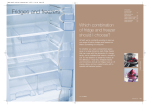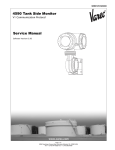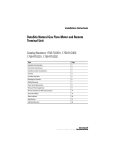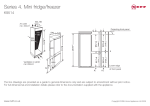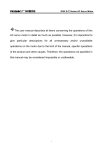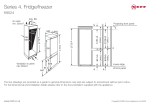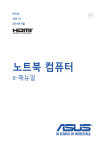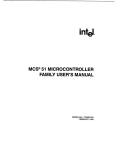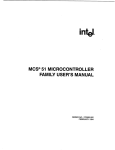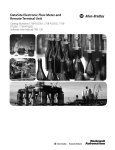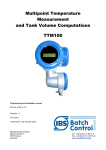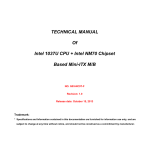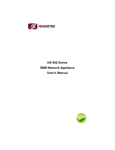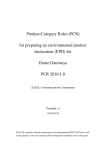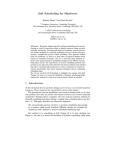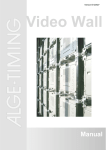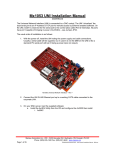Download 目 录
Transcript
Automation Products Series Hardware Manual Applicable to Super32 Series RTU Super32 RTU Manual ECHO Automation Products, Your Successful Choice Honorable users: Welcome to use our automation products and service manuals. With continual improvement of product quality, technical application and service support, Digitron-itralia has successfully launched Rock E series PLC and SuperE series RTU /PLC products, which have been widely applied in automation industry fields. Our products have excellent performance in various application environments and have been appreciated by experts and users. If you use our products for the first time, please carefully read Service Manual when purchasing and using products. In this way, you can further understand performances of our products, reasonably configure hardware and software resource, and truly make our products become the most successful choice. Automation Products Manuals include: "SuperE40 Series RTU Manual " "Super32 RTU Manual " “OpenPCS User Manual” "ESet Manual " “Flow Computer User Manual” "DNP3 Configuration Manual" We will continually update Service Manual and supply site application programs and documents. For any difficulty and problem, please contact our technical service department and we will timely response and help you to solve the problem. You can also access to our website, inquire relevant data and obtain application help from "technology resource ". Copyright Statement Super32 RTU Manual is written by Digitron Italia Applicable to 32 bit series controllers developed by our company. Super32 RTU Manual is protected by intellectual property, and shall not be counterfeited, stolen or illegally copied. In addition to trademarks, products and software names, the contents stated in the manual shall not be duplicated, distributed, converted, transferred or saved in any form of system. The contents involving intellectual property stated in the manual shall not be transferred in any form without our written permission. Products and company names available in this manual belong to registered trademark and copyright, and owned by Digitron Italia. These products, company names, registered trademarks and copyrights shall not be counterfeited except applied as description and explanation. Legal Responsibility The manual is only for reference, without any warranty, and mainly aims to supply information related to product application. We will be not liable to any damage of benefits and products due to the contents of the manual used for other purposes. Meanwhile, to meet the requirement of product update reserves the right to modify manual without notice. About Manual Content The manual is applicable to Super32 Series RTU. Mainly include product introduction, installation application, technical service, etc.: Product Introduction Introduce product configuration, parameter settings, performance target, etc. Installation and Application Introduce product installation, program development, application method, etc. Technical Service Introduce technical support, after service, etc. The Potential Readers Reading Super32 RTU Manual needs certain engineering knowledge. The manual is written for product application engineers, etc. How to Use the Manual If using Super32 RTU for the first time, please read through the manual. If you are an experienced user, can search corresponding information through chapters. Manual content arranged in following chapters: Chapter 1. Summary Chapter 2. Dimensions and Mounting Chapter 3. Field Wiring Chapter 4. Operation Chapter 5. Controller Specification Appendix A. Program Development of Controller Appendix B. Field Wiring Of All Super32 Types Other Help Information Electronic Manual While supplying products, we will also supply CD including Super32 Series RTU and help, etc., please install it on computer for use. Development Help After completing control system, users can adopt EOpen software by ECHO to develop Super32 controller, application methods see our corresponding user manuals. Product Debugging A series of product debugging programs are included into the CD to help understanding product features as quickly as possible. These debugging programs can be obtained from our website. Technical Support For technical consultation, product application training and common difficult problem, please contact us or access our website. Sale Service For product purchase, order and repair, please contact us and our product agents. After receiving products, to ensure your basic benefit, please timely fill in and return product warranty card to us. Table of Contents Table of Contents Table of Contents...........................................................................................................i Chapter 1. 1.1 1.2 Summary............................................................................................. 1 Product Characteristics ............................................................................................................2 Application Requirements ........................................................................................................3 1.2.1 1.2.2 1.2.3 1.2.4 1.2.5 Chapter 2. Programming Requirements .................................................................................................3 Communication Requirements ........................................................................................................3 I/O Requirements ............................................................................................................................4 Power Supply Requirements ...........................................................................................................5 Controller Selection ........................................................................................................................5 Dimensions and Mounting ................................................................ 6 2.1 Outline Dimensions ..................................................................................................................6 2.2 Mounting Controller..................................................................................................................6 2.2.1 Mounting Guidelines.......................................................................................................................7 2.2.2 Mounting Procedure........................................................................................................................8 2.3 Dismantlement .......................................................................................................................10 Chapter 3. Field Wiring....................................................................................... 11 3.1 Outline....................................................................................................................................11 3.2 Field Wiring Connectors .........................................................................................................12 3.3 Connection Mode ...................................................................................................................16 3.3.1 Power Supply Input Wiring...........................................................................................................16 3.3.2 Analog Input(AI)Wiring ..........................................................................................................16 3.3.3 Analog Output(AO)Wiring ......................................................................................................17 3.3.4 Digital Input(DI)Wiring...........................................................................................................18 Super32 RTU Manual i Table of Contents 3.3.5 Digital Output(DO)Wiring.......................................................................................................18 3.3.6 Counter Input(PI)Wiring..........................................................................................................19 3.3.7 Counter Output(PO)Wiring......................................................................................................20 3.3.8 RS232 Serial Communications Wiring .........................................................................................21 3.3.8.1 RS232 DB-9P Connector ......................................................................................................21 3.3.8.2 RS232 DTE to RS232 DTE without Handshaking................................................................24 3.3.8.3 RS232 DTE to RS232 DTE with Handshaking.....................................................................24 3.3.8.4 RS232 DTE to RS232 DCE with Handshaking.....................................................................25 3.3.9 RS485 Serial Communications Wiring .........................................................................................26 3.3.9.1 RS485 Port ............................................................................................................................26 3.3.9.2 RS485 Two-wire Connection Mode......................................................................................28 3.3.9.3 Termination Resistors............................................................................................................29 3.3.10 3.3.11 HART Communications Wiring....................................................................................................30 Ethernet Communication Port .......................................................................................................31 3.3.11.1 Ethernet RJ-45 Connector.....................................................................................................32 3.3.11.2 Ethernet Cable ......................................................................................................................33 3.3.12 3.3.13 Wake Up Wiring ...........................................................................................................................34 CAN Bus Wirings .........................................................................................................................35 Chapter 4. Operation .......................................................................................... 36 4.1 Operating Modes....................................................................................................................36 4.1.1 Run Mode......................................................................................................................................36 4.1.2 Service Mode ................................................................................................................................36 4.2 Sleep Mode ............................................................................................................................37 4.3 LEDs Indicators......................................................................................................................38 4.3.1 Distribution ...................................................................................................................................38 4.3.2 Description ....................................................................................................................................38 4.4 ii 4.3.2.1 System State LEDs................................................................................................................38 4.3.2.2 DI Channel Status LEDs .......................................................................................................38 4.3.2.3 DO Channel Status LEDs......................................................................................................39 4.3.2.4 PI Channel Status LEDs ........................................................................................................39 4.3.2.5 Serial Communications LEDs ...............................................................................................39 4.3.2.6 Ethernet Communications LEDs ...........................................................................................39 Power Control ........................................................................................................................40 Super32 RTU Manual Table of Contents 4.4.1 LED Power Control.......................................................................................................................40 4.4.2 COM1 Power Control ...................................................................................................................40 4.4.3 Ethernet Power Control.................................................................................................................40 4.5 Counter Input Filters...............................................................................................................41 4.6 Real Time Clock.....................................................................................................................41 4.7 Modbus Register Assignment ................................................................................................42 4.8 Assigned Modbus Register Address of I/O Signals................................................................43 4.9 Data Format ...........................................................................................................................43 4.10 Scan Settings of Equipments Connected with COMs ............................................................44 4.11 RS485/RS232 Switch Settings...............................................................................................44 4.12 Communication Parameters...................................................................................................45 4.13 Lithium Battery .......................................................................................................................45 Chapter 5. Controller Specification................................................................... 46 5.1 5.2 CPU Module...........................................................................................................................46 Power Supply .........................................................................................................................46 5.3 Analog Iutput(AI) ...............................................................................................................47 5.4 Analog Output(AO)............................................................................................................47 5.5 Digital Input (DI)................................................................................................................48 5.6 Digital Onput (DO) ............................................................................................................48 5.7 5.8 5.9 5.10 5.11 5.12 Counter Input (PI)...................................................................................................................48 Counter Output (PO) ..............................................................................................................49 RS232 ....................................................................................................................................49 RS485 ....................................................................................................................................49 HART .....................................................................................................................................50 Ethernet .................................................................................................................................50 Appendix A Program Development of Controller............................................... 51 A.1 Method of Development ......................................................................................................51 A.2 Flow of Development ...........................................................................................................52 A.2.1 A.2.2 A.2.3 A.2.4 A.2.5 A.2.6 Read up the Communication Settings of Controller......................................................................52 RS232 Connection Setup ..............................................................................................................52 TCP Connection Setup ..................................................................................................................56 OpenPCS Programming ................................................................................................................59 Configuration ................................................................................................................................74 Controller Operation .....................................................................................................................77 Super32 RTU Manual iii Table of Contents A.3 Source Code Of The Example .............................................................................................78 A.4 OpenPCSDirect Variable Address Definiens .....................................................................81 Appendix B B.1 Field Wiring of all Super32 Types ................................................... 82 Super32-M201.......................................................................................................................82 B.1.1 Field Wiring Connectors ...............................................................................................................82 B.1.2 LEDs Indicators ............................................................................................................................84 B.1.3 LEDs Description..........................................................................................................................85 B.1.3.1 System State LEDs................................................................................................................85 B.1.3.2 DI Channel Status LEDs .......................................................................................................85 B.1.3.3 DO Channel Status LEDs......................................................................................................85 B.1.3.4 PI Channel Status LEDs ........................................................................................................85 B.1.3.5 Serial Communications LEDs ...............................................................................................86 B.1.3.6 Ethernet Communications LEDs ...........................................................................................86 B.1.4 Assigned Modbus Register Address of I/O Signals.......................................................................86 B.2 Super32-L201........................................................................................................................87 B.2.1 Field Wiring Connectors ...............................................................................................................87 B.2.2 LEDs Distribution .........................................................................................................................89 B.2.3 LEDs Description..........................................................................................................................89 B.2.3.1 System State LEDs................................................................................................................89 B.2.3.2 DI Channel Status LEDs .......................................................................................................90 B.2.3.3 DO Channel Status LEDs......................................................................................................90 B.2.3.4 PI Channel Status LEDs ........................................................................................................90 B.2.3.5 Serial Communications LEDs ...............................................................................................90 B.2.3.6 Ethernet Communications LEDs ...........................................................................................91 B.2.4 Assigned Modbus Register Address of I/O Signals.......................................................................91 B.3 Super32-L202........................................................................................................................92 B.3.1 Field Wiring Connectors ...............................................................................................................92 B.3.2 LEDs Distribution .........................................................................................................................95 B.3.3 LEDs Description..........................................................................................................................95 B.3.3.1 System State LEDs................................................................................................................95 B.3.3.2 DI Channel Status LEDs .......................................................................................................95 B.3.3.3 DO Channel Status LEDs......................................................................................................96 B.3.3.4 PI Channel Status LEDs ........................................................................................................96 B.3.3.5 Serial Communications LEDs ...............................................................................................96 iv Super32 RTU Manual Table of Contents B.3.3.6 Ethernet Communications LEDs ...........................................................................................96 B.3.4 Assigned Modbus Register Address of I/O Signals.......................................................................97 B.4 Super32-L203........................................................................................................................98 B.4.1 Field Wiring Connectors ...............................................................................................................98 B.4.2 LEDs Distribution .......................................................................................................................101 B.4.3 LEDs Description........................................................................................................................101 B.4.3.1 System State LEDs.............................................................................................................. 101 B.4.3.2 DI Channel Status LEDs .....................................................................................................101 B.4.3.3 DO Channel Status LEDs....................................................................................................102 B.4.3.4 PI Channel Status LEDs ......................................................................................................102 B.4.3.5 Serial Communications LEDs .............................................................................................102 B.4.3.6 Ethernet Communications LEDs .........................................................................................102 B.4.4 Assigned Modbus Register Address of I/O Signals.....................................................................103 B.5 Super32-L205......................................................................................................................104 B.5.1 Field Wiring Connectors .............................................................................................................104 B.5.2 LEDs Distribution .......................................................................................................................107 B.5.3 LEDs Description........................................................................................................................107 B.5.3.1 System State LEDs.............................................................................................................. 107 B.5.3.2 DI Channel Status LEDs .....................................................................................................107 B.5.3.3 DO Channel Status LEDs....................................................................................................108 B.5.3.4 PI Channel Status LEDs ......................................................................................................108 B.5.3.5 Serial Communications LEDs .............................................................................................108 B.5.3.6 Ethernet Communications LEDs .........................................................................................109 B.5.4 Assigned Modbus Register Address of I/O Signals.....................................................................109 Super32 RTU Manual v Chapter 1 0BSummary Chapter 1. Summary 0 The Super32 RTU is a series of new style common programmable controllers, responsible for signal acquisition and equipment control in situ oriented. With advanced MCU, the products can not only fulfill logic, timing control but also realize data processing, high speed counting, analog quantity control, PID, RTD, TC, communication, networking and so on. The Super32 RTU adopt the standard open design. By comparing with other common programmable controllers, the products have the following characteristics: larger memory capacity, stronger calculation function, simple and convenient programming; powerful communication and network integration capacities which are easy to integrate the network control system with the upper computer and realize distribution control; multiple configurations and function selections which can be ordered according to user needs (system integration, developing and application); superexcellent temperature characteristic and stronger adaptive capacity to environment enable the products to work normally in ill-being. In a word, the series products have the merits of reliable performance, comprehensive functions, flexible applications and high cost-performance ratio. The series products have been widely used in the fields such as petrochemical industry, electric power, metallurgical industry, heat supply, boiler, atmospheric environment, water regime, water supply, sewage disposal, street lamp monitoring, intelligent building and municipal works. Super32 RTU Manual 1 Chapter 1.1 1 0BSummary Product Characteristics Advanced 32-bit ARM chip (ARM technology), embedded real-time multitasking operating system (RTOS). Conform to IEC61131-3; support LD, FBD, IL, ST and SFC programming languages; provide the standard C language program interface. Support I/O signal data collection, logical control and process control; there are several controllers available to meet users' different kinds of demands, the I/O quantities also can be ordered according to user requirements. Support communication protocols such as Modbus RTU/ASCII/TCP, DNP3, have communication interfaces such as RS232, RS485, Ethernet and Hart. The power supply, the signal output and input terminals have been adopted insulation blocking and isolated from the main control circuit. Data power-off protection function, which can store parameters and history data for a long term. The industrial standard design and the DIN guide rail installation structure are convenient for field installation and configuring interior hardware. Premium components and parts that have been checked and screened strictly. Working temperature: - 40 ~70ºC, humidity: 5 ~ 95%RH, applicable for connection of controllers in different kinds of ill-being. 2 Super32 RTU Manual Chapter 1 0BSummary 1.2 Application Requirements The Selection of the Super32 series RTU should according to the practical requirements which can be divided into several aspects as follows: Program requirements Communication requirements I/O requirements Power supply requirement 1.2.1 Programming Requirements A programmable RTU controller, such as Super32-L201, Super32-L202, Super32-M201 is required when: The controller can execute local or remote program control. If there is more than one slave station, the controller is a master station. Data must be saved, processed or stored in the controller in the form of log. A non-programmable controller may be used when: The application System is a terminal-terminal target system. The controller is used for the Remote I/O or subsidiary I/O of a master controller. Without demand such as local control or judgement. 1.2.2 Communication Requirements 9 The communication requirement includes the required kinds and quantities of COM ports of controller. The controller may have any one or several kinds of representative communication modes as follows: Remote slave station Super32 RTU Manual 3 Chapter 2 Dimensions and Mounting Chapter 2. Dimensions and Mounting 2.1 Outline Dimensions Fig. 2-1 2.2 Mounting Controller Super32 controllers mount on 7.5mm by 35mm DIN type rails, as following picture show: Fig. 2-2 DIN Type Guide Rail 6 Super32 RTU Manual Chapter 2 Dimensions and Mounting 2.2.1 Mounting Guidelines Follow these guidelines for mounting modules: DIN rails mount horizontally or vertically, where generally mount horizontally. Modules are easier to install on horizontal rails. Cooling is optimal when mounted horizontally. All the components of Super32 controllers pass the electric certification. Super32 RTU Manual 7 Chapter 2 Dimensions and Mounting 2. Slide the clamp outward, the bottom of the clamp will be outside of the bottom of Super32, as following picture show: Fig. 2-5 3. Drag the controller outward, until the hooks is over the inward lip of the DIN rail, as following pictures show: Fig. 2-6 4. Slide the clamp inward until it meets the outward lip of the rail. The lower edge of the clamp will be flush with the bottom of the controller, as following pictures show: Fig. 2-7 Super32 RTU Manual 9 Chapter 3 Field Wiring Chapter 3. Field Wiring 3.1 Outline The following figure has displayed the outline of Super32-L202 RTU. Fig. 3-1 The Outline of Super32-L202 Super32 RTU Manual 11 Chapter 3 Field Wiring 3.2 Field Wiring Connectors The connecting terminal of Super32 RTU can be divided into three parts: Power supply input terminal. I/O signal wire connecting terminal, such as AI, DI , DO,AO, PI, PO, Wake up, HART etc. Local/Remote communication terminal, such as COM1(RS232/RS485), COM2 (RS232) and the Ethernet interface. Super32-L202 for example, the distribution of terminal groups has been shown as follows: 1) Down Board P8 t e n r e h t E E K s D E L A r W o t c e n n o C pn o ui t ea kn ai Wm ,r Ie DT 7 I D 6 D 5 I D 4 I D 3 I D 2 I D 1 I D 0 I D M O C I D P - U + P6 2 3 2 S R 2 3 2 S R S R n o i t a n r io mt rc ee Tn n Oo DC n o i t a n i m r e Tr Io At ,c r e en wn oo PC a t a D 485 P5 2 M O C P4 1 M O C 1 M O C - + O D P3 d r a o B n w o D 2 0 2 L r e p u S 32- + O D P2 V 0 V 3 O D 2 O D 1 O D O D V V I A 4 I A 3 A 2 I A 1 I A 0 I A + V P1 5 Fig. 3-2 P1 terminal (including power supply, AI output terminal) has been shown in the figure. 12 Super32 RTU Manual Chapter 3 Field Wiring P1 1 2 3 4 5 6 7 8 9 10 V+ V- AI0 AI1 AI2 AI3 AI4 AI5 V- Fig. 3-3 P2 terminal (including DO signal terminal) has been shown in the figure. P2 11 12 13 14 15 16 DO0 DO1 DO2 DO3 DOV+ DOVFig. 3-4 P3 terminal (including RS485 communication terminal) has been shown in the figure. P3 17 Data + 18 _ Fig. 3-5 P4 terminal (including RS232 communication terminal) has been shown in the figure. Fig. 3-6 Super32 RTU Manual 13 Chapter 3 Field Wiring Fig. 3-9 P7 terminal (including HART, PI, AO signal terminal) has been shown in the figure. P7 30 H0+ 31 H0- Fig. 3-10 Super32 RTU Manual 15 32 H1+ 33 H1- 34 H2+ 35 H2- 36 PI0 37 PI1 38 39 40 41 42 43 44 45 PI AOV+ AOV- AO0 AOV- AO1 AOVPI2 COM Chapter 3 Field Wiring 3.3 3.3.1 Connection Mode Power Supply Input Wiring The power supply mode of Super32 RTU is DC24V. 1 2 3 V+ V- Fig. 3-11 “⊥” terminal, is Super32 RTU grounding terminal. In most of application, the best system grounding method is connecting the ground of the system power supply to the ground of chassis or panel of the cabinet. As far as Super32 concerned, after connected terminal with the chassis or earth ground, the grounding work of controller has been completed. Connect "V+" terminal to the "+" end of24V DC. Connect "V-" terminal to the "-" end of 24V DC. 3.3.2 Analog Input(AI)Wiring The AI signal input end has equipped with overvoltage and overcurrent protection to avoid spoilage because of false field connection. The field connection can be divided into two-wire system and three-wire system. The connection mode has been shown as follows: 16 Super32 RTU Manual Chapter 3 Field Wiring PI Filter PI0 Filter PI1 Filter PI2 ON 8~24 V P7 PI0 PI1 PI2 PI- 37 38 39 40 + _ PULSE + OUTPUT _ Fig. 3-16 PI Field Wiring Every counter input has a jumper wire selected filter which limits the maximum input frequency. Use a filter with 50 or 60 HZ AC digital inputs to eliminate contact bounce. The factory default state of this jumper wire selected filter is disabled. 3.3.7 Counter Output(PO)Wiring L205 PO0 PO1 PO2 L O A D L O A D 24V GND L O A D Fig. 3-17 20 Super32 RTU Manual Chapter 3 Field Wiring Super32 RTU Manual 23 Chapter 3 Field Wiring 3.3.8.2 RS232 DTE to RS232 DTE without Handshaking The following figure has shown a standard connection mode between RS232 port and DTE without handshaking signal RS232(DTE) DTE DCD 1 1 DCD RXD 2 2 RXD TXD 3 3 TXD DTR 4 4 DTR GND 5 5 GND 6 6 RTS 7 7 CTS 8 8 9 9 CTS Fig. 3-19 RS232 DTE to RS232 DTE without Handshaking 3.3.8.3 RS232 DTE to RS232 DTE with Handshaking Some DTE (Data Terminal Equipments) need handshaking signal wires. The common wires are CTS and RTS, DTR and DCD are used rarely. The controller has no need of these wires. For details, please refer to the relevant manuals of DTE. The following figure has shown a standard connection mode between RS232 port and DTE with handshaking signal. 24 Super32 RTU Manual Chapter 3 Field Wiring RS232(DTE) DTE DCD 1 1 DCD RXD 2 2 RXD TXD 3 3 TXD DTR 4 4 DTR GND 5 5 GND 6 6 RTS 7 7 RTS CTS 8 8 CTS 9 9 Fig. 3-20 RS232 DTE to RS232 DTE with Handshaking 3.3.8.4 RS232 DTE to RS232 DCE with Handshaking DCE (data communication equipment) needs different signal wires, but in the most general case, DCE must be connected with handshaking signal wire. Note: a majority of DCE belongs to half-duplex communication; when using these equipments, half-duplex should be selected. The following figure has shown a representative connection mode between RS232 port and DCE with handshaking signal. RS232(DTE) DCE DCD 1 1 DCD RXD 2 2 RXD TXD 3 3 TXD DTR 4 4 DTR GND 5 5 GND 6 6 RTS 7 7 CTS 8 8 CTS 9 +5V +5V Super32 RTU Manual 25 9 RTS Chapter 3 Field Wiring end grounding Super32 RTU Manual 27 Chapter 3 Field Wiring Fig. 3-23 RS485 Field Wiring -Two-wire Mode 3.3.9.3 Termination Resistors Termination resistors of 120Ω are required on both physical end on one network segment ,it also means that the two communication ports which on the physical end position of one network segment must be connected with termination resistors, other communication ports of this net segment should not be connected with termination resistors. See Fig. 3-23 RS485 Field Wiring -Two-wire Mode. These termination resistors are installed to make sure the receive data can still be right for the following conditions on the RX line: Open inputs Terminated inputs Sudden inputs (shorted circuit) Super32 RTU Manual 29 Chapter 3 Field Wiring 3.3.10 HART Communications Wiring Super32 controller contains 3 HART protocol communication ports ,one of these is multi-branched port which can connect 13 HART protocol meters. The other two are point to point port which can not only connect HART protocol meters but also collect 4~20mA signals to meet different user’s requirements. Wiring Mode: 1. multi-branched port wiring mode Controller’s HART0 communication port is multi-branched port. H0+ H0- 30 31 - - Two Wire Slave #1 Two Wire Slave #2 + + - ...... Two Wire Slave #13 + + - DC Power Supply Fig. 3-24 HART0 Field Wiring of Passive Meters H0+ H0- 30 31 + Active + 30 DC Power Supply + Active Slave #1 Slave #2 - - ...... + Active Slave #13 - Super32 RTU Manual Chapter 3 Field Wiring Fig. 3-25 HART0 Field Wiring of Active Meters 2. Point to point wiring mode of HART1, HART2 H1+ H1- H2+ H2- 32 33 34 35 - - Two Wire Two Wire Slave #1 Slave #2 + + + + - - DC Power Supply DC Power Supply Fig. 3-26 HART1, HART2 Field Wiring of Passive Meters H1+ H1- H2+ H2- 34 35 34 35 + + + - DC Power Supply Active Active Slave #1 Slave #2 - + - DC Power Supply - Fig. 3-27 HART1, HART2 Field Wiring of Active Meters 3.3.11 Ethernet Communication Port The Super32 controllers have been equipped with built-in Ethernet communication module, before leaving factory. Super32 RTU Manual 31 Chapter 3 Field Wiring 3.3.13 CAN Bus Wirings K1/K2 L203 CANH CANL Fig. 3-32 Super32 RTU Manual 35 24V GND CANH CANL 24V GND Chapter 4 Operation Chapter 4. Operation 4.1 Operating Modes Super32 controllers may start up in RUN and SERVICE mode. Starting the controller in RUN mode automatically executes OpenPCS programs in the controller memory. Starting the controller in SERVICE mode allow controller initialization. 4.1.1 Run Mode The RUN mode is the normal or default operating mode of the Super32 Controller. No action is required to select RUN mode. When power is applied to the controller board: The user defined serial communication parameters, for all COM ports are used. If an OpenPCS program is loaded in RAM, it is executed. 4.1.2 Service Mode 9 SERVICE mode is used during application programming and maintenance work. Using the following procedure to select SERVICE mode: Remove power from the controller. Connect PC to COM2 port of the controller throw a serial line. Executing OpenPCS program, choose [Extras] → [Tools] → [PC Communication 36 Super32 RTU Manual Chapter 4 Operation Settings] in the menu., and the dialog [ESI] will pop up, then select “Connect controller”. Power up the controller, the it will run in Service Mode. When the Super32 controller starts in SERVICE mode, following functions can be achieved through configuration, see Eset Manual for more details. Clear OpenPCS program. Initialize controller communication parameter. Initialize Register. Test Communication. 4.2 Sleep Mode Super32 Controllers are capable of extremely low power operation when in sleep mode. During sleep mode the following happen: All programs stop executing. The power supply of 3.3V which supply power for circuit shut down. The real-time clock and timer continue to function. 12V DC power is not affected. Super32 controllers can switch to sleep mode under control of the application program. One of the following conditions occur to will make the controller switch to sleep mode. A real time clock alarm, defined by application program, occurs. A signal is applied to the WakeUp input. Super32 RTU Manual 37 Chapter 4 Operation 4.4 4.4.1 Power Control LED Power Control Lightening the LEDs on the Super32 controller board will consume a lot of power. Controller can shut these LEDs to conserve power. This feature is particularly useful when the Super32 is using solar powered system or unattended work stations. The ESet configuration sets the default state of the LED power. Application programming can change the enable/disable status. See ESet Manual for detail. The LED power provides power for LEDs if enabled. PWR、RUN are not controlled by the LED power enable/disable status. 4.4.2 COM1 Power Control The insulating power of COM1 port on the Super32 controller board will consume a lot of power. If the controller does not connect with a serial equipment, controller can shut the COM1port to conserve power. This feature is particularly useful when the Super32 is using solar power. The enable/disable status of COM1 power is set by the ESet configuration tool. The application programming may change the enable/disable status. See ESet Manual for detail. TheCOM1 power provides power for COM1 if enabled. COM2 is not controlled by the COM1 power enable/disable status. 4.4.3 Ethernet Power Control Ethernet port on the Super32 controller board will consume more power. If the controller does not connect with an equipment through Ethernet port, controller can shut the Ethernet port to conserve power. This feature is particularly useful when the Super32 is using solar powered. 40 Super32 RTU Manual Chapter 4 Operation The enable/disable status of Ethernet port power is set by the ESet configuration tool.. The application programming may change the enable/disable status. See ESet Manual for detail. The Ethernet port power provides power for Ethernet port if enabled. 4.5 Counter Input Filters Each of the three counter inputs on the Super32 controller can be filtered. Filtering limits the maximum digital input or counter frequency to approximately 30 Hz. Pulse inputs uses filter to resolve for the problems of contact bounce in low speed counting applications. The FILTER 1, FILTER2, FILTER3 switches control the input filter functions: Remove the module cover and set the configuration switches. See Fig. 3-9 Super32 Controller Layout for switch location. To disable a filter, dial the switch to the right side. (open) To enable a filter, dial the switch to the left side. (closed) Fig. 4-2 4.6 Real Time Clock The Real Time Clock of Super32 controller provides independently the time and date for the operating system。The time and date remain correct during power off. The calendar automatically manages leap years. Super32 RTU Manual 41 Chapter 4 Operation 4.12 Communication Parameters The configuration for the parameters of controller should according to the requirements in situ. The primary configurations are parameters of serial communications, Ethernet IP and some other parameters which are relevant to control. For details, please see chapter Controller Communication Settings of ESet Manual. 4.13 Lithium Battery A small lithium battery powers real-time clock when input power is removed. The voltage of a functioning battery should be greater than 2.0V. Application programming can monitor this voltage. If an application program will use the sleep function of controller, please notice about whether it is the voltage of the battery lower than 2.0V.Otherwise, the controller may not be awakened. Refer to the ESet Manual for details. The battery need not be replaced under normal conditions. The using life of the battery is 10 years. The battery is rated to maintain the real-time clock and RAM data for two years with the power off. Accidental shorting or extreme temperatures may damage the battery. The battery is fixed on the circuit board. If necessary, a battery with same performance can be replaced battery seat needn’t to be changed. Super32 RTU Manual 45 Appendix A Program Development of Controller Appendix A Program Development of Controller A.1 Method of Development The Super32 RTU are programmable controllers which support secondary development to order user's required controllers. The required software for the development of control program is EOpen, which conforms to IEC61131-3. EOpen supports IL, LD, ST, SFC and FBD/CFC programming languages, which conform to IEC61131-3. According to the characteristics and requirements of project, users and programmers can select any one or several languages to program and engineers can complete the construction of automation engineering quickly and effectively. EOpen supports monitoring and debugging on-line, simulating off-line. It has strong functions of engineering applications such as controller parameters setup, I/O port read-write, monitoring database. For details, please see OpenPCS manual and ESet manual. Super32 RTU Manual 51 Appendix A Program Development of Controller A.2 A.2.1 Flow of Development Read up the Communication Settings of Controller When given a Super32 RTU, we don’t know its communication settings such as the baud rate of serial port and the IP of Ethernet. Please see the chapter Test Communication of ESet manual to build up the connection. A.2.2 RS232 Connection Setup The procedure to build up RS232 connection in OpenPCS is as follows: Choose[PLC]→[Connections..] in the menu. A dialog will pop up: Fig.A- 1 Click [new], the dialog [Edit Connection] will pop up: 52 Super32 RTU Manual Appendix A Program Development of Controller Fig.A- 2 Input a connection name in the [name] block (my_RS232 for example), See Fig.A-3. Fig.A- 3 Click [Select], and the dialog [Select Driver] will pop up. See Fig.A-4. Select RS232 driver, and click [OK]. Super32 RTU Manual 53 Appendix A Program Development of Controller Fig.A- 4 Click [Settings], and the dialog [RS232 Settings] will pop up. See Fig.A- 6. Fig. A- 5 54 Super32 RTU Manual Appendix A Program Development of Controller Fig.A- 8 Thus, the RS232 connection has been built up in OpenPCS. A.2.3 TCP Connection Setup The procedure to build up TCP connection in OpenPCS is as follows: Choose [PLC]→[Connections..] in the menu. A dialog will pop up: Fig.A- 9 Click [new], the dialog [Edit Connection] will pop up, Input a connection name in the [name] block (my_TCP for example), see below. 56 Super32 RTU Manual Appendix A Program Development of Controller Fig.A- 10 Click [Select], and the dialog [Select Driver] will pop up. See Fig.A-11. Select TCP432 driver, and click [OK]. Note to select the TCP432 driver when using Ethernet communication port, not TCP. Fig.A- 11 Super32 RTU Manual 57 Appendix A Program Development of Controller Fig.A- 14 Fig.A- 15 Thus, the TCP connection has been built up in OpenPCS. A.2.4 OpenPCS Programming We use ST language for example to edit a program. 1、create a new project named Super32_DO. Start OpenPCS , choose [File]→[New] in the menu, click [project], and select [Empty Super32 RTU Manual 59 Appendix A Program Development of Controller Project]. See below:. Fig.A- 16 Fig.A- 17 Input a project name in the [name] block (Super32_DO for example), See below. 60 Super32 RTU Manual Appendix A Program Development of Controller Fig.A- 18 Now the browser contains the new project. You can find the project name in the files pane. See below. Fig.A- 19 Super32 RTU Manual 61 Appendix A Program Development of Controller 2、Create a new program file named DO_ON.ST Choose [File]→[New] in the menu, select ST Program. Select [POU], and input a file name in the [name] block. See below. Fig.A- 20 There may pop up a dialog inquiring whether adding this file to the active resource or not. Click [yes]. See below. Fig.A- 21 You can find the program file name DO_ON.ST in the files pane of the browser. See below. 62 Super32 RTU Manual Appendix A Program Development of Controller Fig.A- 22 3、Create a new Direct Global declaration file named DO_DirectAddress.POE Choose [File]→[New] in the menu, click [Declarations], select [Direct Global], and input a name in the [name] block (DO_DirectAddress), then click [OK]. See below. Fig.A- 23 Super32 RTU Manual 63 Appendix A Program Development of Controller There may pop up a dialog inquiring whether adding this file to the active resource or not. Click [yes]. See below. Fig.A- 24 You can find the program file name DO_DirectAddress.POE in the files pane of the browser. See below. Fig.A- 25 4、Edit DO_DirectAddress.POE Click the file name DO_DirectAddress.POE in the file pane of the browser. And edit the direct global file in the right window. 64 Super32 RTU Manual Appendix A Program Development of Controller Fig.A- 26 The source code, please see Appendix A.3. 5、Edit DO_ON.ST Click the file name DO_ON.ST in the file pane of the browser. And edit the ST program file in the right window. The variable declaration is in the upper window, and the executed code is in the lower window. Super32 RTU Manual 65 Appe Fig.A- 27 The source code, please see Appendix A.3 . 6、Edit resources properties The default resource will need to be configured properly for controller. Open the resources-pane in the left window. 66 Super32 RTU Manual Appendix A Program Development of Controller Fig.A- 28 Find the ‘Resource’ entry in the Resource-Pane, and right-click it to show the context menu, and select ‘Properties’, see below: Fig.A- 29 Super32 RTU Manual 67 Appendix A Program Development of Controller [Edit Resource Specifications] dialog will pop up. Select “ECHO” in the [hardware module]. For the “network connection” item, you should select “my_RS232” when the hardware is RS232 serial connection (see Fig.A- 30 ) or select “my_TCP” when the hardware is TCP432 connection (See Fig.A- 31). Under ‘Optimization’, select ‘Size only’. Then click [OK]. Fig.A- 30 Fig.A- 31 Note to avoid more than one software occupy the same serial port of controller when you use RS232 serial connection. 7、Edit task properties In this example, we want to let the DO_ON task execute one time every second. so 68 Super32 RTU Manual Appendix A Program Development of Controller the DO_ON task will need to be configured to second interruption. Find the ‘DO_ON’ entry in the Resource-Pane, and right-click it to show the context menu, and select ‘Properties’, see below: Fig.A- 32 The [Edit Task Specifications] dialog will pop up. Select “interrupt” In the “Task Type”, and Select “RTC_SEC” In the “Interrupt”. Click [OK]. See below. Fig.A- 33 Super32 RTU Manual 69 Appendix A Program Development of Controller 8、Compile Choose [PLC]→[Build Active Resource] in the menu, or click [Build Active Resource] button in the toolbars. See below. Fig.A- 34 You can see the compiling be running in the diagnostic output window. The last results will be displayed on the diagnostic output window. 70 Super32 RTU Manual Appendix A Program Development of Controller Fig.A- 35 9、Online After compiling finished, choose [PLC] → [Online] in the menu, or click [Online/offline] button in the toolbars to connect the controller. Super32 RTU Manual 71 Appendix A Program Development of Controller Fig.A- 36 10、Download Fig.A- 37 11、Debug Double click variables which under DO_ON entry in turn to add them to the variable watch list. 72 Super32 RTU Manual Appendix A Program Development of Controller Fig.A- 38 12、Run Choose [PLC]→[Coldstart] in the menu, or click [Coldstart] button in the toolbars to reset all variables initial value. Super32 RTU Manual 73 Appendix A Program Development of Controller Fig.A- 39 A.2.5 Configuration The controller will not do any operation, because you have not done any configuration. We have set the DO_ON.ST task type as RTC_SEC interrupt (see Fig.A- 33), and now we should use ESet configuration software to enable the RTC_SEC event interrupt. 1. Build up connection with ESet: Note that, if you use serial connection between ESet tools and the controller, you should firstly be offline in OpenPCS, because the controller can’t communicate with the two software at the same time. So click the [online/offline] button again, to turn to offline state. 74 Super32 RTU Manual Appendix A Program Development of Controller Fig.A- 40 Choose [Extras]→[Tools]→[PC Communication Settings] in the menu. Set the PC baud rate the same as the connected serial port of controller, COM2, 57600 for example. As follows: Fig.A- 41 Super32 RTU Manual 75 Appendix A Program Development of Controller If you use TCP connection between ESet tools and the controller, you need to select “TCP/IP Server” in the “Connection Type”. Fig.A- 42 2. Enable the task interrupt: We use Event Settings to enable the Second Event. You can see the start sentences in chapter Event Settings of ESet Manual for the corresponding relationship between the task interrupt and the Event. Choose [Extras]→[Tools]→[Event Settings] in the menu. The [Event Settings] dialog will pop up. See below. Fig.A- 43 76 Super32 RTU Manual Appendix A Program Development of Controller Check the Second Event check box to enable the second event and [Download] to write the event settings to the controller. See below. Fig.A- 44 Fig.A- 45 A.2.6 Controller Operation Now, you will find that the controller start to execute the OpenPCS program to operate the On/Off switch secondly. Super32 RTU Manual 77 Appendix A Program Development of Controller A.3 Source Code Of The Example 1. source code of DO_DirectAddress.POE VAR_GLOBAL (*Super32-II variables defined*) (*4DO*) Super32_DO_0 : BOOL AT %QX0.0; (*WRITE COIL REGISTER 00001*) Super32_DO_1 : BOOL AT %QX0.1; (*WRITE COIL REGISTER 00002*) Super32_DO_2 : BOOL AT %QX0.2; (*WRITE COIL REGISTER 00003*) Super32_DO_3 : BOOL AT %QX0.3; (*WRITE COIL REGISTER 00004*) (*8DI*) Super32_DI_0 : BOOL AT %IX0.0; (*READ STATE REGISTER 10001*) Super32_DI_1 : BOOL AT %IX0.1; (*READ STATE REGISTER 10002*) Super32_DI_2 : BOOL AT %IX0.2; (*READ STATE REGISTER 10003*) Super32_DI_3 : BOOL AT %IX0.3; (*READ STATE REGISTER 10004*) Super32_DI_4 : BOOL AT %IX0.4; (*READ STATE REGISTER 10005*) Super32_DI_5 : BOOL AT %IX0.5; (*READ STATE REGISTER 10006*) Super32_DI_6 : BOOL AT %IX0.6; (*READ STATE REGISTER 10007*) Super32_DI_7 : BOOL AT %IX0.7; (*READ STATE REGISTER 10008*) (*8AI*) Super32_AI_0 : UINT AT %IW512.0; (*READ INPUT REGISTER 30001*) Super32_AI_1 : UINT AT %IW514.0; (*READ INPUT REGISTER 30002*) Super32_AI_2 : UINT AT %IW516.0; (*READ INPUT REGISTER 30003*) 78 Super32 RTU Manual Appendix A Program Development of Controller Super32_AI_3 : UINT AT %IW518.0; (*READ INPUT REGISTER 30004*) Super32_AI_4 : UINT AT %IW520.0; (*READ INPUT REGISTER 30005*) Super32_AI_5 : UINT AT %IW522.0; (*READ INPUT REGISTER 30006*) Super32_AI_6 : UINT AT %IW524.0; (*READ INPUT REGISTER 30007*) Super32_AI_7 : UINT AT %IW526.0; (*READ INPUT REGISTER 30008*) (*4AO*) Super32_AO_0 : UINT AT %Q512.0; (*WRITE HOLD REGISTER 40001*) Super32_AO_1 : UINT AT %Q514.0; (*WRITE HOLD REGISTER 40002*) Super32_AO_2 : UINT AT %Q516.0; (*WRITE HOLD REGISTER 40003*) Super32_AO_3 : UINT AT %Q518.0; (*WRITE HOLD REGISTER 40004*) END_VAR 2. source code of DO_ON.ST (*variables declaration*) VAR_EXTERNAL (*Super32_DO*) Super32_DO_0 : BOOL ; Super32_DO_1 : BOOL ; Super32_DO_2 : BOOL ; Super32_DO_3 : BOOL ; END_VAR VAR_GLOBAL END_VAR VAR Super32 RTU Manual 79 Appendix A Program Development of Controller END_VAR (*executing code*) Super32_DO_0 := NOT Super32_DO_0; Super32_DO_1 := NOT Super32_DO_1; Super32_DO_2 := NOT Super32_DO_2; Super32_DO_3 := NOT Super32_DO_3; 80 Super32 RTU Manual Appendix B Field Wiring of all Super32 Types Appendix B Field Wiring of all Super32 Types B.1 B.1.1 Super32-M201 Field Wiring Connectors The distribution of Super32-M201 terminal groups shown as follows: t e n r e h t E ) d e v r e s e R ( s D E L p u e k a W I D 2 3 2 S R a t 485 2 3 2 S R a S D R O D I A r e w o P 、 P5 2 M O C 1 M O C P4 1 0 2 M r e p u S 32- 1 M O C P3 - P2 + O D V + O D 0 V 3 O D 2 O D 1 O D O D 5 V V I A 4 I A 3 A 2 I A 1 I A 0 I A + V P1 P - U E K W 7 I D 6 D 5 I D 4 I D 3 D 2 I D 1 I D 0 I D M O C I D 、 P8 + A P6 Fig.B- 1 82 Super32 RTU Manual Appendix B Field Wiring of all Super32 Types P1 terminal (including power supply, AI output terminal) has been shown in the figure. P1 1 2 3 4 5 6 7 8 9 10 V+ V- AI0 AI1 AI2 AI3 AI4 AI5 V- Fig.B- 2 P2 terminal (including DO signal terminal) has been shown in the figure. P2 11 12 13 14 15 16 DO0 DO1 DO2 DO3 DOV+ DOV- Fig.B- 3 P3 terminal (including RS485 communication terminal) has been shown in the figure. P3 17 Data + 18 _ Fig.B- 4 P3 terminal (including RS232 communication terminal) has been shown in the figure. Fig.B- 5 Super32 RTU Manual 83 Appendix B Field Wiring of all Super32 Types Note: P3 and P4 are both COM1 serial ports, they can not be used in RS485 and RS232 at the same time. Only one of them can be selected. P5 terminal (including RS232 communication terminal) has been shown in the figure, it belongs to COM2. Fig.B- 6 P6 terminal (including DI , Wake Up signal terminal ) has been shown in the figure. P6 19 20 21 22 23 24 25 26 27 28 DICOM DI0 DI1 DI2 DI3 DI4 DI5 DI6 DI7 29 WAKE UP + - Fig.B- 7 B.1.2 LEDs Indicators PWR STAT DO0 DO2 DI0 DI2 DI4 DI6 PI0 DO1 DO3 DI1 DI3 DI5 DI7 RUN ERR PI1 PI2 TX0 TX1 TX2 TX LINK RX0 RX1 RX2 RX Fig.B- 8 84 Super32 RTU Manual Appendix B Field Wiring of all Super32 Types B.2 B.2.1 Super32-L201 Field Wiring Connectors The distribution of Super32-L201 terminal groups shown as follows: P8 t e n r e h t E E K s D E L A r W o t c e n n o C pn o ui t ea kn ai Wm ,r Ie DT 7 I D 6 D 5 I D 4 I D 3 I D 2 I D 1 I D 0 I D M O C I D P - U + P6 2 3 2 S R 2 3 2 S R S R n o i t a n r io mt rc ee Tn n Oo DC n o i t a n i m r e Tr Io At ,c r e en wn oo PC a t a D 485 P5 2 M O C 1 M O C 1 M O C P4 d r a o B n w o D 1 0 2 L r e p u S 32- P3 - P2 + O D + O D V 0 V 3 O D 2 O D 1 O D O D V V I A 4 I A 3 A 2 I A 1 I A 0 I A + V 5 P1 Fig.B- 9 P1 terminal (including power supply, AI output terminal) has been shown in the figure. P1 1 2 3 4 5 6 7 8 9 10 V+ V- AI0 AI1 AI2 AI3 AI4 AI5 V- Fig.B- 10 Super32 RTU Manual 87 Appendix B Field Wiring of all Super32 Types P2 terminal (including DO signal terminal) has been shown in the figure. P2 11 12 13 14 15 16 DO0 DO1 DO2 DO3 DOV+ DOVFig.B- 11 P3 terminal (including RS485 communication terminal) has been shown in the figure. P3 17 Data + 18 _ Fig.B- 12 P4 terminal (including RS232 communication terminal) has been shown in the figure. Fig.B- 13 Note:P3 and P4 are both COM1 serial ports, they can not be used in RS485 and RS232 at the same time. Only one of them can be selected. P5 terminal (including RS232 communication terminal) has been shown in the figure, it belongs to COM2. 88 Super32 RTU Manual Appendix B Field Wiring of all Super32 Types B.3 B.3.1 Super32-L202 Field Wiring Connectors The distribution of Super32-L202 terminal groups shown as follows: 1) Down Board P8 t e n r e h t E E K s D E L A r W o t c e n n o C pn o ui t ea kn ai Wm ,r Ie DT 7 I D 6 D 5 I D 4 I D 3 I D 2 I D 1 I D 0 I D M O C I D P - U + P6 2 3 2 S R 2 3 2 S R S R n o i t a n r io mt rc ee Tn n Oo DC n o i t a n i m r e Tr Io At ,c r e en wn oo PC a t a D 485 P5 2 M O C 1 M O C 1 M O C P4 d r a o B n w o D 2 0 2 L r e p u S 32- P3 - P2 + O D + O D V 0 V 3 O D 2 O D 1 O D O D V V I A 4 I A 3 A 2 I A 1 I A 0 I A + V 5 P1 Fig.B- 17 P1 terminal (including power supply, AI output terminal) has been shown in the figure. P1 1 2 3 4 5 6 7 8 9 10 V+ V- AI0 AI1 AI2 AI3 AI4 AI5 V- Fig.B- 18 92 Super32 RTU Manual A P2 terminal (including DO signal terminal) has been shown in the figure. P2 11 12 13 14 15 16 DO0 DO1 DO2 DO3 DOV+ DOVFig.B- 19 P3 terminal (including RS485 communication terminal) has been shown in the figure. P3 17 Data + 18 _ Fig.B- 20 P4 terminal (including RS232 communication terminal) has been shown in the figure. Fig.B- 21 Note:P3 and P4 are both COM1 serial ports, they can not be used in RS485 and RS232 at the same time. Only one of them can be selected. P5 terminal (including RS232 communication terminal) has been shown in the figure, it belongs to COM2. Super32 RTU Manual 93 Appendix B Field Wiring of all Super32 Types B.4 B.4.1 Super32-L203 Field Wiring Connectors The distribution of Super32-L203 terminal groups shown as follows: 1) Down Board P8 t e n r e h t E E K s D E L A r W o t c e n n o C pn o ui t ea kn ai Wm ,r Ie DT 7 I D 6 D 5 I D 4 I D 3 I D 2 I D 1 I D 0 I D M O C I D P - U + P6 2 3 2 S R 2 3 2 S R S R n o i t a n r io mt rc ee Tn n Oo DC n o i t a n i m r e Tr Io At ,c r e en wn oo PC a t a D 485 P5 2 M O C 1 M O C 1 M O C P4 d r a o B n w o D 3 0 2 L r e p u S 32- P3 - P2 + O D + O D V 0 V 3 O D 2 O D 1 O D O D V V I A 4 I A 3 A 2 I A 1 I A 0 I A + V 5 P1 Fig.B- 27 P1 terminal (including power supply, AI output terminal) has been shown in the figure. P1 1 2 3 4 5 6 7 8 9 10 V+ V- AI0 AI1 AI2 AI3 AI4 AI5 V- Fig.B- 28 98 Super32 RTU Manual A P2 terminal (including DO signal terminal) has been shown in the figure. P2 11 12 13 14 15 16 DO0 DO1 DO2 DO3 DOV+ DOVFig.B- 29 P3 terminal (including RS485 communication terminal) has been shown in the figure. P3 17 Data + 18 _ Fig.B- 30 P4 terminal (including RS232 communication terminal) has been shown in the figure. Fig.B- 31 Note:P3 and P4 are both COM1 serial ports, they can not be used in RS485 and RS232 at the same time. Only one of them can be selected. P5 terminal (including RS232 communication terminal) has been shown in the figure, it belongs to COM2. Super32 RTU Manual 99 Appendix B Field Wiring of all Super32 Types B.5 B.5.5 Super32-L205 Field Wiring Connectors The distribution of Super32-L205 terminal groups shown as follows: 1) Down Board P8 t e n r e h t E E K s D E L A r W o t c e n n o C pn o ui t ea kn ai Wm ,r Ie DT 7 I D 6 D 5 I D 4 I D 3 I D 2 I D 1 I D 0 I D M O C I D P - U + P6 2 3 2 S R 2 3 2 S R S R n o i t a n r io mt rc ee Tn n Oo DC n o i t a n i m r e Tr Io At ,c r e en wn oo PC a t a D 485 P5 2 M O C 1 M O C 1 M O C P4 d r a o B n w o D 5 0 2 L r e p u S 32- P3 - P2 + O D + O D V 0 V 3 O D 2 O D 1 O D O D V V I A 4 I A 3 A 2 I A 1 I A 0 I A + V 5 P1 Fig.B- 37 P1 terminal (including power supply, AI output terminal) has been shown in the figure. P1 1 2 3 4 5 6 7 8 9 10 V+ V- AI0 AI1 AI2 AI3 AI4 AI5 V- Fig.B- 38 104 Super32 RTU Manual A P2 terminal (including DO signal terminal) has been shown in the figure. P2 11 12 13 14 15 16 DO0 DO1 DO2 DO3 DOV+ DOVFig.B- 39 P3 terminal (including RS485 communication terminal) has been shown in the figure. P3 17 Data + 18 _ Fig.B- 40 P4 terminal (including RS232 communication terminal) has been shown in the figure. Fig.B- 41 Note:P3 and P4 are both COM1 serial ports, they can not be used in RS485 and RS232 at the same time. Only one of them can be selected. P5 terminal (including RS232 communication terminal) has been shown in the figure, it belongs to COM2. Super32 RTU Manual 105 Appendix B Field Wiring of all Super32 Types P3 terminal (including DO terminal) has been shown in the figure. P3 18 19 20 21 DO0 DO1 DO2 DO3 22 23 DO4 DO5 24 25 26 27 DO6 DO7 DOV- DOV+ Fig.B- 50 P4 terminal (including AO terminal) has been shown in the figure. P4 28 AO0 29 30 31 AO- AO1 AO- 32 33 34 35 AO2 AO- AO+ AO- Fig.B- 51 P5 terminal (including RS485 communication terminal) has been shown in the figure. P5 36 37 RS485-0 D0- D0+ 38 39 RS485-1 D1- D1+ 40 41 RS485-2 D2- D2+ Fig.B- 52 P6 terminal (including RS232 communication terminal) has been shown in the figure. It belongs to COM0. Fig.B- 53 Super32 RTU Manual 111
































































































































